by Susan Dean | Feb 2, 2018 | Food and Health Dangers, Health

This is the latest research on pesticides and insecticides in our food. Buy organic or better yet – Grow your own.
Fruits and Pesticides
Apples – Cancer causers, hormone disruptors and neurotoxins have all been detected on apples, 98 percent of which test positive for pesticides. Because they’re so popular and are eaten daily by so many people, apples earned the top spot on EWG’s list of foods you should always buy organic.
Blueberries – More than 40 different pesticides were found on blueberries grown in the U.S.
Cherries – One of the most commonly used pesticides on cherries, carbaryl, is suspected of causing cancer and may lead to neurological diseases such as Parkinson’s and to birth defects.
Nectarines – The USDA found the average imported nectarine contained more pesticides by weight than any other food. Domestically grown nectarines didn’t fare much better. They contained the same range of pesticides, but at lower levels.
Peaches – Many of the pesticides used on peaches are systemic. They’re sprayed on a tree before it bears fruit, but the chemicals wind up getting into the fruit as it grows, and there’s no way to remove them.
Pears – 92 percent of pear samples tested positive for at least one pesticide residue, while 26 percent were tainted with 5 or more pesticides.
Imported Plums – The most common pesticide found on plums imported from abroad (mostly Chile) is iprodione, which the Environmental Protection Agency has dubbed a “likely” carcinogen.
Strawberries A single sample of strawberries tested by the USDA contained 13 different pesticides.
Grapes – More pesticides are used on grapes than on any other fruit. Combined, the various samples of grapes used in the 2012 EWG report contained 64 different pesticides.
5 Pesticide Foods to Avoid and Why:
1. Peaches. Farmed peaches are number one because so many pesticides are needed to grow them. Their skin absorbs much of it infecting the flesh with carcinogenic chemicals that outweigh the peach’s natural health benefits.
2. Apples. Many apples are grown in mid-western states where they are not native and haven’t developed natural defenses to predators. They are treated with many harmful pesticides that seep into the peel. You can peel your apples but lose a third of the nutrients and some flavor.
3. Sweet Bell Peppers. This vegetable has the highest likelihood of containing multiple pesticides (64 found on a single sample)
4. Celery. This vegetable has no skin and the pesticides are absorbed directly into the plant. It’s best to buy this fresh and organic.
5. Strawberries. Their skin doesn’t absorb as much as a peach but they are small and we don’t often wash them carefully. The Organic Trade Association stated that more than 371 pesticides are approved for use on U.S. strawberries and because they grow close to the ground, they are subject to chemicals used on soils.
The Dirty Dozen
When it comes to these items, try to buy these in organic form to avoid the excessive amounts of pesticide.
1. Strawberries
2. Celery
3. Apples
4. Peaches
5. Spinach
6. Nectarines
7. Kale/collard greens
8. Sweet bell peppers
9. Lettuce
10. Blueberries
11. Potatoes
12. Grapes
The Clean 15
These 15 produce items are known by the EWG as the “clean 15″. They have the least amount of pesticides and would be considered the items to buy if you can’t afford to go completely organic.
1. Grapefruit
2. Sweet corn (This is generally GMO, so you may want to always stick to organic with corn)
3. Pineapples
4. Avocado
5. Mushrooms
6. Cantaloupe
7. Sweet potatoes
8. Eggplant
9. Sweet peas
10. Kiwi
11. Cabbage
12. Watermelon
13. Mangoes
14. Onions
15. Asparagus
Based on an analysis conducted over a period of time between 2001 – 2009 by the USDA and FDA, 53 popular produce items were tested creating a series of 51,000 tests. The produce items were rinsed and peeled to recreate the general conditions in which they are consumed. The conclusion of the analysis confirmed that if someone were to eat from the clean 15 and purchased organically from the dirty dozen, they would lower their pesticide intake by 92%.
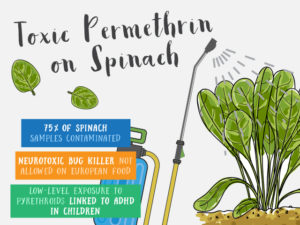
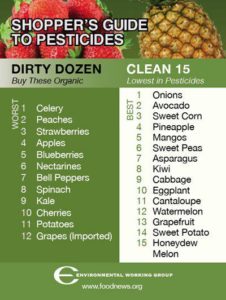
by Susan Dean | Feb 2, 2018 | Food and Health Dangers, Health

#1: Food Allergies. Researchers from Albert Einstein College of Medicine at Montefiore Medical Center in New York City found an association between food allergies and the levels of a pesticide breakdown product in urine. People with high levels of dichlorophenol, a breakdown product of the herbicide 2,4-D and of chlorine used to disinfect tap water, were more likely to suffer allergies to milk, eggs, seafood, and peanuts. Dichlorophenol acts like an antimicrobial and could interfere with healthy bacterial levels in the gut, which, in turn, could upset the body’s natural immune reactions to certain allergens in food.
#2: Memory Loss. Another review from University College London recently concluded that low levels of pesticides, such as those considered safe for farm workers who are exposed on a daily basis, cause significant damage to cognitive function—your memory, the speed at which you process information, and your ability to plan for the long term. The review used data from 14 different studies and looked at organophosphate pesticides, which are some of the most harmful chemicals used in agriculture.
#3: Diabetes. Scientists have been noticing a link between pesticides and diabetes for years. The latest evidence comes out of the Endocrine Society’s 94th Annual Meeting, where Robert Sargis, MD, PhD, released the results of a study that suggest tolyfluanid, a fungicide used on farm crops, creates insulin resistance in fat cells. A 2011 study published in Diabetes Care found that overweight people with higher levels of organochlorine pesticides in their bodies faced a higher risk of developing type 2 diabetes.
#4: Cancer. More than 260 studies link pesticides to various cancers, including lymphoma, leukemia, soft tissue sarcoma, and brain, breast, prostate, bone, bladder, thyroid, colon, liver, and lung cancers, among others. The President’s Cancer Panel suggests eating organic and avoiding plastic to lower your risk of environmentally triggered cancers.
#5: Autism & Other Developmental Diseases. How do you get autism? The world’s leading autism researchers believe the condition develops from a mix of genes and the pollutants encountered in the mother’s womb and early in life. Many insecticides effectively kill bugs by throwing off normal neurological functioning. That same thing appears to be happening in some children. A 2010 Harvard study found that children with organophosphate pesticide breakdown materials in their urine were far more likely to live with ADHD than kids without the trace pesticide residues.
#6: Obesity. Some agrochemical pesticides act as hormone disruptors, meaning they act like a fake version of a naturally occurring hormone in your body, they block important hormone communication pathways in the body, or they interfere with your body’s ability to regulate the healthy release of hormones. More than 50 pesticides are classified as hormone disruptors, and some of them promote metabolic syndrome and obesity as they accumulate in your cells, according to 2012 study appearing in Environmental Health Perspectives.Food isn’t the only place where these obesogenic chemicals could be lurking. Avoid canned foods and other foods packaged in plastic. Studies have shown that chemicals, such as BPA and phthalates, in food packaging could play a role in obesity as well.
#7: Parkinson’s Disease. More than 60 studies show a connection between pesticides and the neurological disease Parkinson’s, a condition characterized by uncontrolled trembling. The association is strongest for weed- and bug-killing chemical exposures over a long period of time, meaning it’s important to keep these toxic compounds out of your household routine. Uuse natural pest control measures.
#8: Infertility. Pesticides spell trouble in the baby-making department, thanks to their bad habit of not staying put. Atrazine, a common chemical weed killer used heavily in the Midwest, on Southern sugar cane farms, and on golf courses, has been detected in tap water. Doctors and scientists point to published evidence tying atrazine to increased miscarriage and infertility rates. Other pesticides cause a plunge in male testosterone levels. A 2006 study found chlorpyrifos, a chemical used in nonorganic apple and sweet pepper farming, and carbaryl, a go-to pesticide in strawberry fields and peach orchards, caused abnormally low testosterone levels.
#9: Birth Defects. Babies conceived during the spring and summer months—a time of year when pesticide use is in full swing—face the highest risk of birth defects. During these months, higher pesticide levels turn up in surface waters, increasing a mother’s risk of exposure. Spina bifida, cleft lip, clubfoot, and Down syndrome rates are higher when moms become pregnant during high season for pesticides.
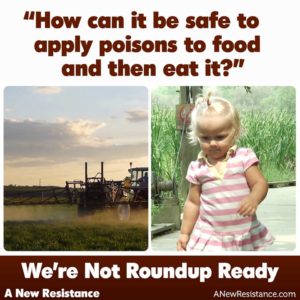
WEED KILLER? USE VINEGAR NOT ROUNDUP
Spray plants with inexpensive white vinegar. Use vinegar on gravel paths and brick walk-ways. It is a proven effective, eco-friendly answer to Roundup. Monsanto agreed with the New York Attorney General’s office to discontinue the use of the terms “biodegradable” and “environmentally friendly” in ads promoting Roundup. These terms were lies. Roundup is not biodegradable nor environmentally friendly. Vinegar is cheap and easy to use. How to Apply: use a watering can, a spray bottle or a pump-sprayer to apply vinegar. Rinse sprayer after use, or metal part can corrode. Make your application on a warm, sunny, calm day. Use vinegar on walkways where grass and ornamental plants are not an issue. It keeps pathways free of unwanted growth. You can also use plain salt water.
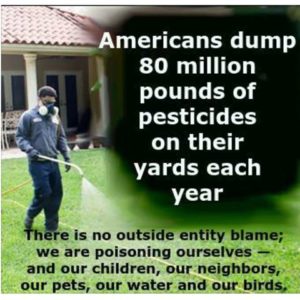
by Susan Dean | Feb 2, 2018 | Food and Health Dangers, Health
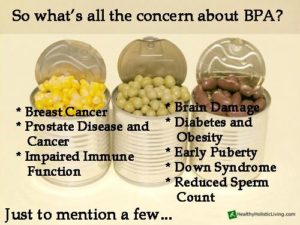
The Serious Dangers of BPA The canned-food chemical bisphenol A, or BPA, has been under attack for years, with studies suggesting it’s associated with negative health impacts ranging from cancer and obesity to infertility and heart disease.
BPA is a common hormone-disrupting chemical used as a liner in metal food and drink cans and in cash-register receipts.
A new study published in the Proceedings of the National Academy of Sciences is strengthening the push to ban BPA, showing that levels found in most Americans is increasing breast cancer risk in monkeys, a close relative of humans.
“These findings strongly suggests that BPA is a breast carcinogen in humans, and human exposure to BPA should be curtailed,” says study coauthor Ana M. Soto, MD, professor of anatomy and cell biology at Tufts University School of Medicine in Boston.
A pregnant monkeys’ low-level exposure caused abnormal changes in the offspring’s breast tissue. The offspring’s mammary glands were denser, one of the leading risk factors in breast cancer.
BPA is chemically related to diethylstilbestrol, an estrogen that increases the risk of breast cancer in both rodents and in women exposed in the womb. BPA is an estrogen, and estrogens are considered carcinogens.
Research on BPA and breast cancer risk involves fetal exposure and cancer that develops decades later. A study published in the journal Circulation showed a direct link between high BPA exposure in healthy adults and greater risk of developing heart disease. BPA overrides the female body’s natural heartbeat signaling causing arrhythmia (erratic beating that could cause sudden cardiac death) in heart tissue testing.
No matter what your age, and regardless of your desire to become pregnant, it’s in everyone’s best interest to reduce BPA exposure.
The Food and Drug Administration was sued and forced to consider a BPA ban in food packaging, but said earlier this year it needed more time to determine whether the chemical threatens human health.
A few companies say they are planning to move away from use of BPA in canned goods, including Campbell’s Soup. Some canned food companies, like Eden Foods, have already removed BPA from cans and named the replacement. Campbell’s, however, isn’t naming the replacement chemical or saying when the BPA ban will go into effect. Some researchers fear BPA replacement chemicals could be just as bad—or worse—than BPA.
Avoiding canned food and drinks is a great way to reduce BPA exposure, but because the chemical is produced in heavy volumes and used in so many products, many public health experts believe government needs to intervene to cut back on this toxic exposure.
If we try to decrease our exposure to BPA by reducing the use of plastics and canned food, and avoiding to touch credit card receipts, there’s no way of knowing if we’ve reduced exposure by 5 percent or 95 percent; thus, what we need is regulatory action to decrease human exposure to BPA.
by Susan Dean | Feb 2, 2018 | Food and Health Dangers, Health
Monosodium Glutamate (MSG)
Commonly found in Chinese food, MSG is used as a flavor enhancer in soups, salad dressings, chips and frozen foods. In people sensitive to the compound, MSG can overexcite cells, producing uncomfortable symptoms. Research shows a correlation between overconsumption of foods containing MSG and medical conditions such as depression, disorientation, eye damage, fatigue, headaches, and obesity.
Artificial Sweeteners (Aspartame/Saccharine/Mannitol) are packed with chemicals that can be harmful to your body. Most of these sweeteners contain the Aspartame. Studies have suggested Aspartame is linked to a wide spectrum of health problems like brain tumors, diabetes, lymphoma, multiple sclerosis, Parkinson’s, Alzheimer’s, fibromyalgia, chronic fatigue, and emotional disorders like depression and anxiety. It has also been linked to symptoms including dizziness, headaches, nausea, mental confusion, seizures, and affects short-term memory and intelligence.
BHA And BHT may prevent your food from changing color, losing flavor, or becoming rancid, but it has been suggested they can increase chances of getting cancer. However, FDA states that BHA and BHT are safe to consume, and another study published by the NCBI (National Center for Biotechnology Information) compared them with Vitamin E. Not certain? You’ll find them in everything from gum to cereals — just check the label and opt out.
Trans fat found in many processed foods can be one of the most dangerous substances to consume. It occurs naturally in some animal products, and is synthetically created by adding hydrogen to vegetable oils. Used to extend the shelf life of many food products, the consumption of trans fats, according to the FDA, raises LDL (bad cholesterol). Elevated levels of LDL increase the risk of high blood pressure, potentially resulting in heart attack, stroke, diabetes and heart disease.
Sodium Nitrate (naturally occurring compound) and Sodium nitrite (synthetically created compound) are both commonly used to preserve meat products in place of salt. Both are nitrosamines, which studies have shown when consumed in large amounts over time damage DNA, potentially resulting in cancers, and the development of pulmonary diseases.
Artificial Food Coloring can have a very negative effect on your health. FDA studies exploring the effect of dyes on children’s behavior were inconclusive, prompting more studies to be undertaken. Some studies have suggested food dye may cause thyroid cancer, kidney and adrenal tumors, and chromosome deterioration.
Sodium Sulfite is frequently used during wine production and can be found in dried fruit. It can cause dangerous reactions in people sensitive or allergic to it. One study found it induced cell degranulation and oxidant stress. It has been linked to asthma, rashes, headaches, and breathing problems.
Sulfur Dioxide is a toxic additive, commonly found in beer, dried fruits such as apricots, chips and soft drinks. While no definitive study has linked it to negative health effects it is feared in foods because as a gas, inhaling too much can cause conjunctivitis, bronchitis, emphysema, bronchial asthma, and potentially cardiovascular disease.
High-Fructose Corn Syrup is found in almost all processed foods. It has become the number one source of calories in America. Beware! High-fructose corn syrup, which provides zero nutritional benefit, is found in the healthy foods we eat as well. Be sure to check the labels of yogurts, cereals, and granola bars for this harmful additive.
Potassium Bromate is used to increase the volume of bread products, this additive has been proven to cause cancer in animals. It is banned as an additive in the EU, Canada and Brazil, but not in the United States. California is the only state that requires labels for products with potassium Bromate.
by Susan Dean | Feb 2, 2018 | Food and Health Dangers, Health
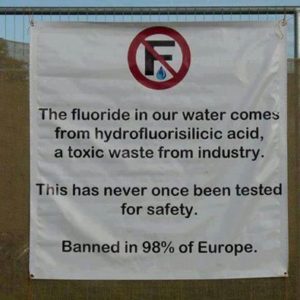 1. Bottle-fed infants receive the highest doses of fluoride as they rely solely on liquids for food, combined with their small size. A baby being fed formula receives approximately 175 times more fluoride than a breast-fed infant.
1. Bottle-fed infants receive the highest doses of fluoride as they rely solely on liquids for food, combined with their small size. A baby being fed formula receives approximately 175 times more fluoride than a breast-fed infant.
2. There is not a single process in your body that requires fluoride
3. A multi-million dollar U.S. National Institutes of Health (NIH) -funded study found no relation between tooth decay and the amount of fluoride ingested by children
4. Water fluoridation cannot prevent the oral health crises that results from inadequate nutrition and lack of dental care
5. Water fluoridation is a violation of your individual right to informed consent to medication
6. Forty-one percent of all American children aged 12-15 are now impacted by dental fluorosis, rising to more than sixty percent of children in fluoridated communities
7. The chemicals used to fluoridate water supplies are largely hazardous and highly toxic by-products of the fertilizer industry and have never been required to undergo randomized clinical trials for safety or effectiveness by any regulatory agency in the world
8. The U.S. FDA classifies ingested fluoride for purposes of reducing tooth decay as an “unapproved drug”
9. Ingesting fluoride has been found to damage soft tissues (brain, kidneys, and endocrine system), as well as teeth (dental fluorosis) and bones (skeletal fluorosis). There are 24 studies demonstrating a strong relationship between fairly modest exposure to fluoride and reduced IQ in children
10. Fluoridation discriminates against those with low incomes. People on low incomes are least able to afford avoidance measures, such as reverse osmosis filters or bottled water
The Sierra Club opposes mandatory water fluoridation. Some reasons cited include possible adverse health effects, harm to the environment, and risks involving sensitive populations.
Arvid Carlsson, winner of the 2000 Nobel Prize for Medicine, opposes water fluoridation. He took part in the debate in Sweden, where he helped to convince Parliament that it should be illegal due to ethics. He believes that it violates modern pharmacological principles, which indicate that medica
tions should be tailored to individuals.

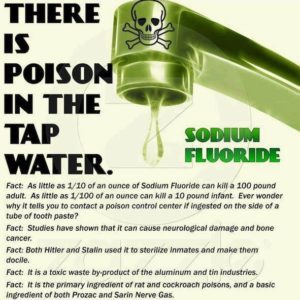


by Susan Dean | Feb 2, 2018 | Food and Health Dangers, Health
#1) Maltodextrin (from GM corn) If you pick up a natural product and the ingredients list says “maltodextrin,” chances are very high that the maltodextrin in the product is derived from Monsanto’s GM corn.Products that are certified USDA organic, however, are not using GMO maltodextrin. The non-GMO, non-corn replacement for maltodextrin derived from GM corn is tapioca maltodextrin, and you’ll find tapioca starch / maltodextrin in many certified organic, non-GMO products. Corn maltodextrin should be avoided unless it’s certified USDA organic. Look for tapioca maltodextrin instead (or no maltodextrin at all).
#2) Vitamin C / ascorbic acid (from GM corn) Nearly all the “vitamin C” sold in vitamins across America is derived from GMO corn. Most of the supplements sold are routinely made with genetically modified vitamin C. It’s typically called “ascorbic acid,” and nearly 100% of the ascorbic acid used in the natural products industry is derived from GMOs. Sourcing non-GMO vitamin C requires going outside the United States. There is no supply chain of certified organic, non-GMO ascorbic acid available in America.
#3) Hexane-extracted soy and rice proteins – Nearly 100% of the “natural” soy proteins and rice proteins sold in the USA are extracted in China using a hexane extraction method. This is true for brown rice protein superfood as well as the soy protein used in nearly all so-called “protein bars. Hexane is a highly explosive chemical. It is not only extremely hazardous to the environment; there may be trace amounts of hexane left remaining in the resulting protein products. Hexane extraction is not allowed in certified organic proteins, so if you have a choice, go for certified organic instead of just “natural” (which means nothing anyway). Hexane extraction is also used in the manufacture of textured vegetable protein
#4) High levels of Aluminum in detox products – Natural News helped expose high aluminum levels (over 1200ppm) in a popular detox liquid, causing the main U.S. distributor to issue a “recall” notice and provide over $1 million in refunds to customers. The manufacturer of this product, Adya Clarity, intentionally and knowingly deceived consumers by mislabeling the product and not mentioning the 1200ppm of aluminum it contained. The FDA seized some of the products and ran its own lab tests, confirming the high aluminum level as well as identifying multiple labeling violations.
Adya Clarity is just one of many so-called “detox” products containing alarming levels of aluminum and other metals. Ingesting these in order to “detox” your body may be harmful to your health. This experience proves you can’t always trust health products sold through online webinars, where manufacturers can ignore labeling laws and fabricate false claims. Buyers beware when it comes to metals in detox products that claim seemingly magical results.
#5) Lead and arsenic in herbs from China – China is the most polluted nation on the planet (by far), yet many fruits, vegetables and herbs are grown in China and exported to North America for use in natural products. High levels of lead and arsenic are routinely found in various food, supplement and herbal products from China. When lead, arsenic, mercury and cadmium get to high saturation levels (or are present in inorganic forms), it makes the products potentially a source of heavy metals poisoning for consumers. Many companies that import and retail products from China conduct no metals testing. Everything packed under the brand name Health Ranger Select is independently tested to ensure full product safety and regulatory compliance.
#6) Inorganic minerals in cheap vitamins – Would you eat iron filings and call it nutrition? Most of the cheap vitamins sold today are made with iron filings. “Scrap metal,” almost.
The calcium found in cheap vitamins is often just ground-up seashells, and magnesium is often sold as cheap magnesium oxide which may be completely useless to your body’s cells. If you’re buying mineral supplements, you may be wasting your money unless the minerals are in the right form: Magnesium orotate or malate, for example.
But the No. 1 best source for all minerals is fresh plants. If you really want to boost your minerals, feed them to sprouts or garden plants, then eat or juice those plants. Your body wants “organic” minerals from plants, not inorganic minerals from rocks.
#7) Carrageenan? The Cornucopia Institute, a highly-effective food activism group recently published a warning about carrageenan in foods. Cornucopia says carrageenan is linked to “gastrointestinal inflammation, including higher rates of colon cancer, in laboratory animals.”
Given its effect on gastrointestinal inflammation, Cornucopia urges anyone suffering from gastrointestinal symptoms (irritable bowel syndrome/IBS, spastic colon, inflammatory bowel disease, chronic diarrhea, etc.) to consider completely eliminating carrageenan from the diet to determine if carrageenan was a factor in causing the symptoms.
#8) Acrylamides – Acrylamides are cancer-causing chemicals produced during the cooking of carbohydrates. Fried snack chips, for example, contain acrylamides. They don’t have to be listed on labels because they are technically not “ingredients.” They are chemicals produced during cooking or frying. Consuming acrylamides increases kidney cancer risk by 59 percent. The FDA has published an extensive reference guide on acrylamide levels in foods, revealing that french fries have the highest levels of all. But they are also present in prune juice and even breakfast cereals.
A bag of organic snack chips can have just as many acrylamides as a bag of conventional snack chips. This is why fried snack chips should be eaten only sparingly, or never at all. Vitamin C blocks acrylamides from causing damage to your body. If your vitamin C is from a GMO source you may want to rethink that strategy. Natural citrus juice, rose hips or even camu camu berry powder is a much better choice of natural, full-spectrum vitamin C. If you eat fried foods of any kind, make sure you ingest a lot of vitamin C, astaxanthin and chlorella before and after your meal or snack.
#9) Hidden MSG / yeast extract – Hidden MSG is a huge issue across the natural products industry. Pick up almost any veggie burger, and you’ll find it’s made with yeast extract, a hidden form of MSG (monosodium glutamate). Yeast extract is unbelievably prevalent in the food industry because it looks nicer on the label than “MSG.” Most people are trained to avoid MSG, but yeast extract slips by, so food manufacturers put it into canned soups, dip mixes, snack chips, microwave dinners and especially in vegetarian products, many of which are so loaded with chemicals and additives that I won’t dare touch them. Just because a food says “vegetarian” doesn’t mean it’s healthy. Hidden MSG is also labeled as “autolyzed yeast extract” or “torula yeast” or even “hydrolyzed vegetable protein.”
#10) Fluoride in green tea – Green tea is famous for being contaminated with high levels of fluoride. This is frustrating, because green tea is phenomenally good for your health. It has been proven to lower “bad” cholesterol levels, and it may even help prevent cancer and neurological disorders. It’s probably one of the healthiest beverages you can ever drink.
The tea plant that produces green tea just happens to uptake a huge amount of fluoride from the soils. So when there’s fluoride present in those soils, the green tea will have a surprisingly high concentration, sometimes as much as 25ppm.
While this fluoride in green tea might not be a health hazard all by itself, the governments of the world seem insistent on pumping even more synthetic, chemical fluoride into the water supplies, thereby creating a high risk for fluorosis. Adding green tea to the fluoride consumption you might experience from tap water is a recipe for disaster: brittle bones, discoloration of teeth and even cancer.
The final “dirty little secret” of the natural products industry – Most importers, packers, vendors and retailers of natural products foolishly trust the lab results provided by the manufacturers and exporters! A typical U.S. company that sells, for example, pomegranate powder on the internet may never conduct their own tests for lead, mercury, cadmium, arsenic and aluminum. They will simply take the lab tests provided by the manufacturer and consider those to be absolute fact! Growers and exporters routinely lie about their lab tests in order to pull the wool over the eyes of importers, formulators and retailers. The lab tests are easily faked or simply bought off in their home country. Contaminated products can be easily sold and exported because the FDA doesn’t routinely check imported raw materials for heavy metals contamination.
On the good news side, all the higher-end retailers such as Natural News, Mercola, Gary Null, etc., routinely test their raw materials for contaminants. Gaia herbs (www.GaiaHerbs.com) routinely tests all their batches, and VitaCost, before it changed hands a few years ago, was running their own lab to test raw materials on-site.
Look for the USDA organic logo when you buy “organic” products. If they don’t have the logo, they aren’t really organic.












